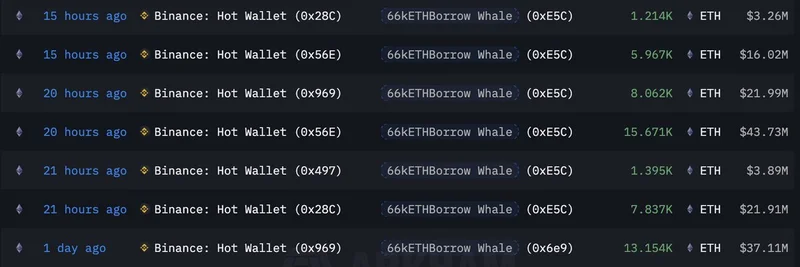In the fast-paced world of cryptocurrency, big players—often called "whales"—can make waves with their moves. Recently, onchain analysis firm Lookonchain spotlighted one such whale, dubbed the #66kETHBorrow Whale, who's been aggressively accumulating Ethereum (ETH). Over the past two days, this entity has snapped up 114,684 ETH, worth about $319.4 million, bringing their total holdings to a staggering 489,696 ETH—valued at around $1.35 billion.
This isn't just a simple buy; it's a leveraged play using DeFi protocols. The whale has racked up $647.7 million in debt on Aave, a popular decentralized lending platform where users can borrow assets by posting collateral. In this case, the whale is likely using their ETH or other assets as collateral to borrow stablecoins, which they then use to purchase more ETH. It's a strategy that amplifies gains if ETH's price rises but comes with risks—like liquidation if the price drops too low. Lookonchain notes the whale's liquidation price is around $1,594 per ETH, meaning if ETH falls to that level, their position could be automatically sold off to repay the loan.
The activity builds on an earlier update from Lookonchain, where the whale added another 7,837 ETH ($21.9 million) to their stack, pushing holdings to 440,558 ETH ($1.23 billion at the time). These purchases appear to involve transfers from Binance's hot wallets, suggesting the whale is buying on the exchange and then moving the ETH to their personal address for use in DeFi.
Why This Matters for Ethereum and Beyond
For those new to crypto, a "whale" is someone holding a large amount of a particular asset, enough to potentially influence market prices with their trades. Onchain analysis tools like those from Lookonchain or Arkham Intelligence track these movements by monitoring blockchain transactions, giving the community insights into smart money behavior.
This whale's bullish bet on ETH comes at a time when Ethereum is navigating market volatility. By borrowing to buy more, they're essentially going long on ETH, betting the price will climb higher than their borrowing costs and liquidation threshold. If successful, it could signal confidence in Ethereum's future, perhaps driven by upcoming upgrades, increased adoption, or broader market recovery.
Connecting the Dots to Meme Tokens
At Meme Insider, we focus on the wild world of meme tokens, many of which live on the Ethereum blockchain. So, how does this ETH whale activity tie in? Ethereum serves as the backbone for countless meme coins—from classics like Shiba Inu (SHIB) to the latest viral sensations. A rising ETH price often boosts the entire ecosystem, as higher gas fees become more tolerable, and more capital flows into DeFi and NFTs, which in turn can spill over to meme projects.
If this whale's accumulation helps propel ETH prices upward, it could create a fertile ground for meme token pumps. Whales like this one might even deploy some of their ETH into liquidity pools or new launches, amplifying hype and trading volumes. On the flip side, if ETH dips toward that $1,594 liquidation point, it could trigger a cascade of selling, pressuring meme tokens built on Ethereum as well.
We've seen similar patterns before: Large-scale borrowing and buying can fuel bull runs, but they also heighten risks in interconnected DeFi systems. For meme token enthusiasts, keeping an eye on these whale moves via platforms like Lookonchain or Arkham Intelligence is key to staying ahead.
What to Watch Next
As the crypto market evolves, tracking these onchain signals can provide valuable clues. Will this whale continue stacking ETH, or is this the peak of their borrowing spree? And how might it influence popular meme tokens like PEPE or DOGE-inspired variants on Ethereum?
Stay tuned to Meme Insider for more breakdowns on how big money moves impact the meme coin space. If you're diving into DeFi yourself, remember to manage risks—leverage can be a double-edged sword.
For the full details, check out the original thread on X (formerly Twitter).




